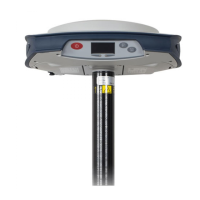
Do you have a question about the Spectra SP80 and is the answer not in the manual?
| Channels | 240 |
|---|---|
| SBAS | WAAS, EGNOS, MSAS, GAGAN |
| Data Logging Rate | Up to 20 Hz |
| Internal Memory | 8 GB |
| Power Consumption | 4.5 W |
| Operating Temperature | -40°C to +65°C |
| Ingress Protection | IP67 |
| BeiDou | B1, B2 |
| Galileo | E1, E5a, E5b |
| Position Accuracy (RMS) - RTK | 8 mm + 1 ppm |
| Communication | Bluetooth, Wi-Fi, USB |
| Battery Life | 10 hours |
| Frequency Range | 410-470 MHz |
| Output Power | 2 W |
| Battery | 7.4 V (Li-Ion) |
| Position Accuracy (RMS) - Static | 3 mm + 0.5 ppm (Horizontal), 5 mm + 0.5 ppm (Vertical) |
Lists items included in the SP80 GNSS Receiver Kit.
Details the optional UHF kit and its components.
Details the optional Field and Office Power Kits and their cables.
Step-by-step guide for charging the receiver batteries before first use.
Detailed steps for inserting batteries into the receiver compartments.
Steps for inserting SIM and SD cards into the receiver slots.
Warning about correct SIM card insertion location to prevent damage.
Using SP80 with field software, connection feedback, and battery monitoring.
Explains icons and data on the General Status screen for rover/base.
Details status indicators for battery, modem, WiFi, SD card, Bluetooth, and USB.
Explains position solution displays, coordinates, and satellite info.
Explains how to read battery status using front panel LEDs.
Details LED status for one or two batteries in field operation.
Explains battery status changes and automatic power switching.
Details LED status when AC/DC power block is connected.
Setting up a network rover via cell modem, WiFi, or data collector.
Setting up a network base via cell modem or WiFi for RTK corrections.
Detailed steps for recording GNSS raw data onto storage medium.
Explains ways to transfer G-files to a computer via SD card or field software.
Steps for charging batteries using the separate dual battery charger.
Charging batteries while they remain inside the receiver.
Explains the purpose and basic function of the anti-theft feature.
How to enable/disable the anti-theft protection via data collector.
Describes normal operation and initial position saving with anti-theft active.
Conditions that cause a theft alarm to be triggered based on position.
Describes receiver actions and notifications upon theft detection.
Steps to set up and configure anti-theft protection in Survey Pro.
Details the Alerts Tab for setting up contacts and notification levels.
Steps to add contacts and specify communication methods for alerts.
How to enable/disable protection via the Survey menu and prompts.
Steps to set up and configure anti-theft protection in FAST Survey.
Configuring network, email addresses, and phone numbers for alerts.
Configuring email server settings and testing email communication.
Setting up phone numbers for SMS alerts and receiving theft alerts.
Buttons for enabling, testing, password, and disabling anti-theft.
Overview of using UHF kits for RTK base/rover systems.